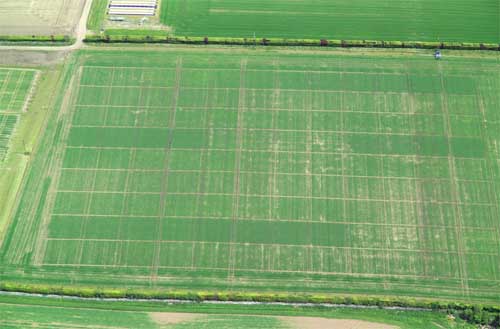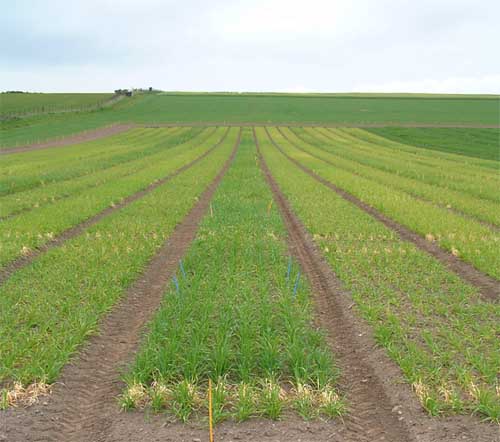Towards a low-nitrogen future
Published on 21 December 2010 in Sustainability and Communities
Introduction
Efficient use of nitrogen (N) by plants is critical for maintaining future crop productivity as artificial fertilisers become more costly to produce. Global N fertiliser use for crop production has increased approximately seven-fold in the last 50 years, enabling crop production to keep pace with population growth. However, the economic and energy costs of high N inputs to arable systems are not considered sustainable.
Production of artificial N fertilisers is expensive, requiring conversion of N gas into inorganic N, which relies on fossil fuels. The cost of N fertilisers has more than doubled in recent years, and prices are likely to increase further as fossil fuel supplies become limited. In addition, uptake and use of N fertiliser in cropped systems can be inefficient.
Globally, it has been estimated that only one-third of the N fertiliser applied to cereal crops ends up in the harvested grain. The N in agricultural soils is a major source of greenhouse gases such as nitrous oxides, and N can also be lost through leaching of nitrates into water courses. There is an urgent need for alternative crop management strategies to allow sufficient food production for human populations without exhausting global resources.
A combined approach is required to reduce our reliance on artificial N fertilisers for crop production. The key questions are:
- What are the alternatives to chemically-synthesised N fertilisers? We need to consider alternative sources of N, including recycled farmyard and urban organic waste and green manures.
- Can existing crop varieties maintain yield and quality with less artificial fertiliser and/or alternative fertilisers? We need new crop genotypes that are more efficient in the use of inorganic and organic forms of applied nitrogen.

Figure 1: Compost and slurry trials at Mylnefield, SCRI, showing the enhanced early development of the barley crop when quality green compost is used.
Key Points
Our research indicates that alternative sources of N fertiliser, such as recycled urban green waste, can improve soil structure and crop quality. The benefits to crop yield and soil fertility are perceived cumulatively over several applications, and yields are not immediately comparable with the maximum yields achieved using artificial fertilisers. In addition, we suggest that modern crop varieties, bred for maximum yield with large artificial N inputs, might not possess sufficient genetic variation to achieve current yields under reduced N fertiliser inputs.
Even if all known options are deployed, food production will still have to rely on manufactured N to maintain current yields. We therefore conclude that a phased approach is required over the next two decades to design alternative approaches to crop-management that can supplant manufactured inorganic N with alternative N sources and to deploy advanced crop varieties.

Figure 2: Barley N use efficiency trials at Gourdie, Dundee.
Research Undertaken
Field experiments were performed by SCRI and SAC to address the two questions posed above. Firstly, experiments to examine the impact of green compost and farmyard slurry on cereal and potato crops demonstrated significant positive effects of compost amendment on crop quality, and on pest and disease control. Crop establishment and development were noticeably improved, particularly early in the season when quality green compost was used. Soil nutrient levels increased under large compost additions, indicating that soil fertility levels and crop yields will improve cumulatively with successive compost additions.
Secondly, existing varieties of crops such as barley and oilseed rape have been examined for their nitrogen use efficiency (NUE) under conventional N fertiliser inputs and with low or no N fertilisation. NUE is the yield gain per unit of N available to the crop, and is the net effect of several processes controlling the availability, uptake and use of N.
Our research has shown that while modern varieties are more efficient at both taking up and transferring N to the grain under standard N fertilisation, their productivity is severely decreased with reduced N fertiliser addition. We are therefore exploiting the differences between modern and old varieties of barley to identify traits, particularly in the roots, that enable plants to perform better when N inputs are reduced. This work will lead to recommendations for traits to incorporate into crop breeding programmes for reduced input systems.
Policy Implications
Our research findings on the impact of alternative fertilisers on crop production and soil health are highly relevant to policy issues regarding the production and use of artificial fertilisers, which can pollute and which are dependent on costly and limited fossil fuel resources. Recycled wastes can aid crop production but cannot replace artificial fertilisers as a means of maximising yields. Therefore, current agricultural output cannot be maintained solely with low artificial N inputs. Instead, scientists, growers and policymakers need to focus on designing systems that increase further the efficiency of N use in agricultural systems to maximise yields and to minimise N losses. The cultivation of crops such as high value N-fixing legumes should be expanded to increase biological N inputs to the soil and to secure food production in Scotland.
Author
Ali Karley, Ron Wheatley, Philip White, Geoff Squire, Cathy Hawes (all SCRI), Ian Bingham (SAC) Alison.Karley@scri.ac.uk
Topics
Sustainability and Communities





